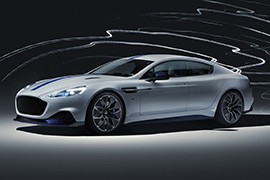ASTON MARTIN Rapide E Models/Series Timeline, Specifications & Photos
First production year: 2019
Engines: Electric
Body style: Coupé (two-door)
Aston Martin surprised its customers in 2019 when it unveiled the Rapide E at the Shanghai Motor Show, its four-door gran tourer powered by electrons instead of a V12.
The British automaker was aware of the electric car revolution but was not quite ready for it in 2019. Unlike other automakers, it didn’t develop an entirely new platform to accommodate the batteries inside the floor and the electric motors in all corners of the vehicle. Instead, it took a regular Rapide four-door sedan and transformed it into a go-fast EV that it produced in 155 units for selected customers. But the E was not just a regular Rapide with an electric drivetrain. To create it, the car manufacturer had to modify many other parts of the vehicle and make it suitable to wear the Aston Martin badge up front, and for that, it needed trustworthy partners to provide high-quality and high-performance underpinnings for the car.
Aston Martin extensively used aluminum alloys to make the Rapide E, and then it added multiple carbon fiber elements that lowered the car’s drag resistance by 8%. At the front, the E sported a similar-looking black grille, but part of it was blocked to improve aerodynamics, and EVs didn’t need such a large cooling area anyway. The headlights that flanked the grille looked similar to the ones from the V12-powered version but sported LED technology. Lower, on the bumper, the automaker added a new carbon fiber splitter, and the side scoops featured tiny holes that cooled the front brakes.
With the Rapide, Aston Martin was already in a special league of go-fast four-door coupes. It was an awaited car, and customers loved it. That’s why the overall shape of the vehicle didn’t change. Still, a keen eye for detail could notice some differences between the V12-powered and the electron-powered versions. On the front fenders, the automaker added specific E badges behind the wheel arches and below the side-mounted vents. Moving towards the back, the automaker installed new side sills made from carbon fiber. At the back, the automaker kept the same shape for the taillights but improved them thanks to the LED technology. Under the bumper, the Rapide E featured a broad diffuser made to improve aerodynamics, not create downforce.
Inside, the luxurious cabin of the E version of the Rapide greeted its driver with a 10-inch display inside the instrument cluster that was unique for this version of the Aston Martin. In addition, the center stack sported a touchscreen infotainment system that featured additional menus specific to electric cars. Still, Aston Martin didn’t want its customers to be deprived of the comfortable bucket seats from the regular Rapide, so it used them here as well. In the back, the bench seat was wide enough to accommodate three people, but the automaker profiled it just for two passengers. But it wasn’t a vehicle made for long journeys across continents since it featured a 300-liter (10.6 cu-ft) trunk. Its size was reduced compared with the regular Rapide due to the electric drivetrain.
Under the hood, Aston Martin installed the battery pack, which weighed about less than the V12 engine used for the rest of the Rapide range. The automaker also ditched the gearbox and the driveshaft and installed two electric motors for the rear wheels. Thanks to the 800-Volt architecture and the 65 kWh battery pack, the car could be recharged quickly at 100 kW chargers. Its 200-mile (321-kilometer) range was not spectacular, but it was considered enough for the first electric Aston Martin.
